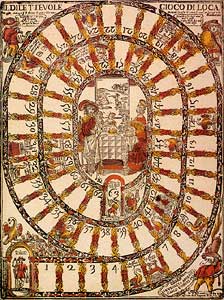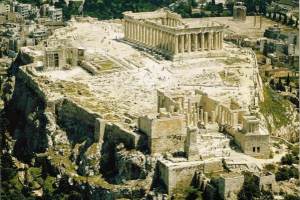Posts Tagged ‘history of games’
 Greek and Roman games are one of the little known aspects of these ancient societies.
Greek and Roman games are one of the little known aspects of these ancient societies.
In Hellenistic and Roman culture skill games were a recreational activity both for children and adults.
Since prehistoric times is possible to recognize the so-called ancestors of games and toys among the archeological finds and in the works of Hellenic and Romans artists and poets:
We know for sure that in the fifth century BC, Crater, an Athenian playwright, wrote a play dedicated to skill games.
In ancient Rome writer Suetonius wrote two different books one on Greek kids games, and the other on the Romans ones: unfortunately all these works got lost and we know only a few certain things about ancient Greek and Roman skill games.
A lot of references are traceable in the works of philosophers, poets, playwrights who, helped us to understand that in every ancient game there was a deep educational theory to help and support kids development through the use of their skills.
In the ancient Roman world the expression “nuces relinquere” (leave the nuts), meant leaving childhood and becoming adult, because nuts were used by kids to play one of the most popular skill game in ancient Rome . The nuts were used like balls and thrown to to smash other nuts, just like in the modern bowling game.
Read the rest of this entry »
Gomoku (五目並べ) is a Japanese traditional logic board game, related with the game of Gobang (which uses the same board and pieces), and it’s also know in English countries as Five in a Row.
The rules of the game of Gomoku are in fact different and much simpler than the Gobang game and for this reason it’s a board game played mainly by children. But despite its simples rulres Gomoku is a strategy and logic board game more complex and difficult than Tic Tac Toe (also called Nine Mens Morris) and the modern Connect Four. Read the rest of this entry »
- In: board games | Curiosities | Educational | History
- Leave a Comment

Egyptian gooses

Ancient Italian goose game
In 1640, a new board game called “Game of the goose” appeared for the first time.
The game of the goose was published in Venice (Italy) by Carlo Coriandoli. The first stamp of this game represents a family sitting at the table covered with food off all kind with a big roasted goose in the centre.
The name “game of the goose” probably derives from this first stamp, although many studious declare that the origin of the name comes from the particular player’s habit of using the won money to buy a big goose.
Certainly the game of the goose has ancient origins, that can be tracked down in many documents recovered in ancient Egyptian tombs.
The goose game represents in a board game the eternal struggle of good vs evil: the goose must defeat evil overcoming all the obstacles of the game.
The game board of the goose game is composed by 90 coded boxes (in the ancient one they were only 63) arranged in a spiral. The aim of the goose game is to roll the two dices and get from square 1 to square 90 before the other player. Yo do this we have to be lucky enough to avid the penalty boxes.
The goose game is very simple and it doesn’t request particular abilities, the player wins with the fortune of the dices.
The game of the goose spread quickly in all European countries and was really popular especially among literate and intellectuals. After several years the basic model of the game was reinvented and evolved in many different versions called with many different names during our history: the “owl game”, the “war game”, the “travel game”, the “train game”.
- In: board games | Curiosities | Educational | History
- 1 Comment

Knights Templars
The triple wall is the pattern of the popular board game called Nine Men’s Morris in England, Morabaraba in South Africa, Naukhadi in India, Molenspiel in Germany and Jeu de Moulin in France. The triple square symbol was find in Italy, UK, Ireland and Afghanistan and in a lot other regions of the Middle East engraved or painted in holy places for Christianity and Islam.
The aim of the Nine Men’s Morris is to form a row of three pieces along the board’s lines and leave the opposing player with no moves.
This is the playing function of this geometric concentric figure, but we can find the same pattern in ancient churches and in the Chinon tower in France, engraved on the walls by Templar Knights kept prisoners during the Middle Ages.
Some researchers suggest that this geometric draw could be the symbol of an ancient and esoteric ritual made by knights Templars.

the triple square symbol
For example, René Guénon, affirm that this symbol represent, in ancient religous rituals, a sort of holy centre where the world energies can reach the right power to involve a man’s mind on a mystic level.
The origins of the triple square are still unknown but without any reasonable doubt we can say that its symbolism is related to the centre and the balance of the world and the human spheres represented by the pieces of the game have to converge to find the perfect equilibrium.
The geometric scheme of the Nine Men’s Morris game represent the route that men have to follow to find themselves without lose the right way in unethical directions. In this sense the triple square has a manicheistic meanining deeply related to the Middle Ages religious symbolism.
God is the origin and the centre of all the universe and everything has to point in His direction; it’s clear in this interpretation the religious and ethical meaning of this symbol directly derived from the holy circle used by ancient civilizations of the far East to show the solar wheel also called the wheel of life.

Assyrian Solar Wheel
All those clues made the researchers think that the symbol of the triple square in the Middle Ages was not used as a game but as a religious symbol and only after several years this geometric pattern was used as the board of the game known with the name of Nine Men’s Morris.

The Nine Men’s Morris game derived from the triple square symbol
Games and toys in ancient Rome
Posted on: August 11, 2009
- In: History | toys | Train Your Brain
- Leave a Comment

Dives in ancient Rome
Games and toys such as dolls, hobbyhorses, balls, hand-carts, and many others playthings characterized all the playing and recreational activities in Ancient Rome.
The hedonistic lifestyle and the enjoyment of life was one of the most important aspect of this ancient Roman culture and every occasion was good to play games.
A lot of finds in many archaeological sites around Rome and central Italy help researchers to piece together all games and amusements played in the roman empire from toys for children to skill games, gambling and sports games.
Like modern times even ancient Rome games where a stress relief moment and the best way to evade with the fantasy and don’t think to the harshness of the life.
A lot of ancient games were popular among children and adults, with the difference that adults utilized those same games to gamble. This is the case of dives games and of the Astragalus game, played with small animal bones.
 Other gambling games were animal fights, permitted only during the Saturnalias, the ancient roman carnival festivity; other popular games where coin flip, and the tic-tac-toe game practised on rudimental game boards, often engraved on the public sidewalk. There was also a game called ludus latrunculorum (soldiers’ game) which represents a primitive version of chess and checkers; In this ancient board game all the pawns of the board were moved like an army during a battle.
Other gambling games were animal fights, permitted only during the Saturnalias, the ancient roman carnival festivity; other popular games where coin flip, and the tic-tac-toe game practised on rudimental game boards, often engraved on the public sidewalk. There was also a game called ludus latrunculorum (soldiers’ game) which represents a primitive version of chess and checkers; In this ancient board game all the pawns of the board were moved like an army during a battle.
Last but not the least the ball game, played by people of all ages wit balls created with plumes, cloths and sand.


 The Mahjong (麻雀麻将), is a
The Mahjong (麻雀麻将), is a  Another legend attributes the invention of the Mahjong game to the great Chinese philosopher Confucius, around 500 BC.
Another legend attributes the invention of the Mahjong game to the great Chinese philosopher Confucius, around 500 BC.

Gaming comments